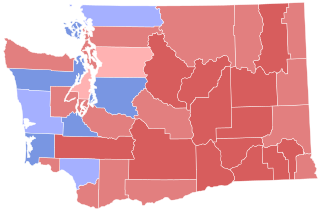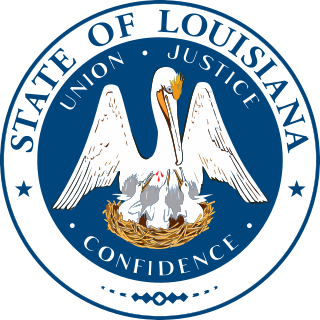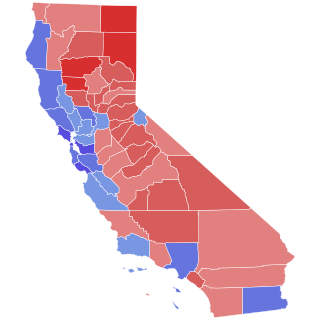
Primary elections or primaries are elections that are held to determine which candidates will run for an upcoming general election. Party primaries are elections in which a political party selects a candidate. Depending on the country and administrative division, there may be an "open primary", in which all voters are eligible to participate, or a "closed primary", in which only members of a political party can vote.

The 2004 Washington gubernatorial election was held on November 2, 2004. The race gained national attention for its legal twists and extremely close finish, among the closest political races in United States election history. Republican Dino Rossi was declared the winner in the initial automated count and again in a subsequent automated recount, but after a second recount done by hand, Democrat Christine Gregoire took the lead by a margin of 129 votes.

The American Independent Party (AIP) is an American political party that was established in 1967. The American Independent Party is best known for its nomination of Democratic then-former Governor George Wallace of Alabama, who carried five states in the 1968 presidential election running against Richard Nixon and Hubert Humphrey on a populist, hard-line anti-Communist, pro-"law and order" platform, appealing to working-class white voters. Wallace was best known for his staunch segregationist stances. In 1976, the party split into the modern American Independent Party and the American Party. From 1992 until 2008, the party was the California affiliate of the national Constitution Party. Its exit from the Constitution Party led to a leadership dispute during the 2008 election.

Sam S. Reed is an American accountant and politician who served as the 14th Secretary of State of Washington from 2001 to 2013 and is a member of the Republican Party. Reed was Washington's fourteenth secretary of state. He retired in January 2013.

The 2008 gubernatorial election in Washington was held on November 4, 2008. Republican Dino Rossi and incumbent Democratic Governor Christine Gregoire emerged from the August 19 primary. This made the 2008 election a rematch between the candidates from the 2004 election, the closest gubernatorial election in the state's history. In contrast to the recounts and months of legal challenges in their previous contest, Gregoire was the clear winner on November 5 with about 53% of the vote. With a margin of 6.48%, this election was the second-closest race of the 2008 gubernatorial election cycle, behind only the election in North Carolina.
California Democratic Party v. Jones, 530 U.S. 567 (2000), was a case in which the United States Supreme Court held that California's blanket primary violates a political party's First Amendment freedom of association.
The blanket primary is a system used for selecting political party candidates in a primary election, used in Argentina and historically in the United States. In a blanket primary, voters may pick one candidate for each office without regard to party lines; for instance, a voter might select a Democratic candidate for governor and a Republican candidate for senator. In a traditional blanket primary the candidates with the highest number of votes for each office in each party advance to the general election, as the respective party's nominee. Blanket primaries differ from open primaries – in open primaries voters may pick candidates regardless of their own party registration, but may only choose among candidates from a single party of the voter's choice. A blanket primary gives registered voters maximum choice in selecting candidates among those systems that separate primary from general elections. Blanket primary elections also serve as polls for the general elections, revealing the portion of votes that the candidates are expected to receive in them.
An open primary is a primary election that does not require voters to be affiliated with a political party in order to vote for partisan candidates. In a traditional open primary, voters may select one party's ballot and vote for that party's nomination. As in a closed primary, the highest voted candidate in each party then proceeds to the general election. In a nonpartisan blanket primary, all candidates appear on the same ballot and the two highest voted candidates proceed to the runoff election, regardless of party affiliation. The constitutionality of this system was affirmed by the Supreme Court of the United States in Washington State Grange v. Washington State Republican Party in 2008, whereas a partisan blanket primary was previously ruled to be unconstitutional in 2000. The arguments for open primaries are that voters can make independent choices, building consensus that the electoral process is not splintered or undermined by the presence of multiple political parties.
From April 1998 to March 1999, five special elections were held in the Oakland and Berkeley area. The process was triggered by the mid-term retirement of U.S. Representative Ron Dellums and ended one year later with the unexpected election to the California State Assembly of Green Party candidate Audie Bock, by which time turnout had fallen to just 15% of registered voters.

Elections in California are held to fill various local, state and federal seats. In California, regular elections are held every even year ; however, some seats have terms of office that are longer than two years, so not every seat is on the ballot in every election. Special elections may be held to fill vacancies at other points in time. Recall elections can also be held. Additionally, statewide initiatives, legislative referrals and referendums may be on the ballot.

The political balance in Louisiana was heavily affected by the post-Hurricane Katrina departure from New Orleans. Heavily Democratic New Orleans lost some 1/3 of its population. The overall effect reduced the Democrats' base of support in the state and turned Louisiana into a Republican-leaning state thereafter. New Orleans remained Democratic, electing Mitch Landrieu as mayor in February 2010. In the 2008 elections, Louisiana sent a mixed result, with the election of U.S. Senator John McCain for President and the reelection of Democratic U.S. Senator Mary Landrieu. The other senator, at the time, was Republican David Vitter.

Ballot Measure 65 was an initiated state statute ballot measure for the November 4, 2008 general election ballot in the state of Oregon. If it had passed, it would have replaced the current closed primary election system for partisan offices, in which each political party nominates its own candidate for the general election. The system proposed by Measure 65 bore similarities to a blanket primary and nonpartisan blanket primary.

Initiative 872 was a 2004 ballot initiative that replaced the open primary being used in Washington state with a top-two nonpartisan blanket primary. It was challenged in court up to the US Supreme Court, which upheld the top-two primary in Washington State Grange v. Washington State Republican Party.

Proposition 14 is a California ballot proposition that appeared on the ballot during the June 2010 state elections. It was a constitutional amendment that effectively transformed California's non-presidential elections from first-past-the-post to a nonpartisan blanket primary. The proposition was legislatively referred to voters by the State Legislature and approved by 54% of the voters. It consolidated all partisan primaries for a particular office into an election with one ballot that would be identical to all voters, regardless of their party preferences. The two candidates with the most votes in the primary election would then be the only candidates who would run in the general election, regardless of their party affiliation.

The 2014 California Secretary of State election was held on November 4, 2014, to elect the secretary of state of California. Incumbent Democratic secretary of state Debra Bowen was term-limited and ineligible to run for re-election to a third term in office.

A unified primary is an electoral system for narrowing the field of candidates for a single-winner election, similar to a nonpartisan blanket primary, but using approval voting for the first round, advancing the top-two candidates, allowing voters to confirm the majority-supported candidate in the general election.
The Moxie Media scandal was a 2010 political scandal in Washington state. In that year's state senate primary elections, small political consulting firm Moxie Media engaged in astroturfing that resulted in a surprise loss for incumbent Jean Berkey. In an out-of-court settlement, the state fined Moxie $290,000, but the scandal had no negative long-term consequences for them. Winner Nick Harper stated he knew nothing about the scheme and became state senator despite efforts to delay his swearing in. Though the state's Democratic Party recognized Harper's achievements, rumors of an extramarital affair dogged him, and he resigned in late 2013.

The 2014 California State Treasurer election was held on November 4, 2014, to elect the State Treasurer of California. Incumbent Democratic Treasurer Bill Lockyer was term-limited and ineligible to run for re-election to a third term in office.

Alaska Measure 2 was a ballot initiative narrowly approved by voters in Alaska as part of the 2020 United States elections. The proposal switched Alaska's primary system to a non-partisan blanket primary. The top four candidates progress to the general election, which is conducted with ranked-choice voting. Voting for U.S. president will continue to utilize primaries based on political party, but ranked-choice voting will still be used in the general election. The initiative also requires additional disclosures of campaign financing.

A final-four or final-five primary is an electoral system using a nonpartisan primary by multi-winner plurality in the first step.













